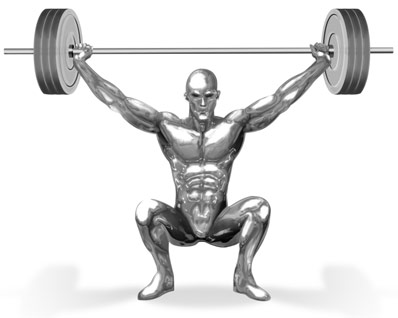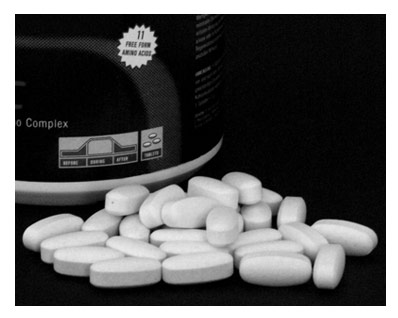28-Days-to-Lean Meal Plan
With the right plan and the right discipline, you can get seriously shredded in just 28 days.
Read articleThis week we're proud to launch a new column right here at M&F online, in which Justin Grinnell B.S., CSCS, NASM-CPT answers questions you post to our Facebook page. Each Thursday we'll start a new thread on Facebook asking for your training and nutrition questions and answer three right here the following Thursday.
So, start asking over at our Facebook thread now, and check out our answers to last week's questions below.
A: While bodybuilders don’t typically focus on incorporating Olympic lifts—such as the clean and snatch—into their training, these exercises can be of great benefit for those looking to gain muscle. Because of the unique neural demands Olympic lifts place on the body, Olympic lifts can help you become a more athletic lifter, as they hits untapped fast twitch muscle fibers that would not be stressed during a traditional lift, such as chest press or biceps curl.

If you ever go to an Olympic lifting competition you will notice two things; one, they have big traps and shoulders due to the pulling phase of an Olympic lift, and two, they have fantastic quads, since they have to drop down into a deep front squat with heavy loads. That is why I usually add Olympic lifts to either a leg or shoulder and trap workout.
I've had great success helping my clients break through plateaus and gain new muscle incorporating OLY lifts into their routine. Below is a lower body workout that is sure to shock your legs into gaining newfound size and strength!
Lower-body Routine w/Olympic Lifts
Exercise Sets Reps
Power/Hang Clean to Front Squat* 4 3-6
Front Squats (Heavy) 2 8
1-Leg Rear Foot Elevated Squat 3 8-10 each
Barbell Stiff-Leg Deadlift 3 8-10
Reverse Hyperextensions 3 15
*Make sure to learn correct technique by warming up with 2-3 sets with light weight. For beginners use the hang position, and for advanced use the power position for the clean.
[ pagebreak ]
A: It doesn’t matter how long you've been training, a plateau is sure to creep up on you at some point. It's always frustrating; to work so hard in the gym, and make sure you're eating all of your meals, yet see your progress come to a stand still!
Below are five common reasons why we hit plateaus and answers for breaking through them:
REASONS FOR PLATEAUS

1. Training inneficiency
2. Inadequate recovery time
3. Training infrequency
4. Lack of amino acids
5. Not enough variety
SOLUTIONS
1. It's a natural instinct to want to add more to your workout in order to get better—more sets, more exercises, more reps, etc. However total focus on each and every set and rep trumps volume every time. If you dial it in on each exercise and muscle group and perform every set and rep to your highest capabilities you can get as much out of six sets as you can 12. Make sure to limit your “junk” sets and focus on being efficient in the gym.
2. If you're training a muscle group twice a week make sure to leave at least 48-72 hours between training sessions for that muscle. In addition, your body will require no less than seven and up to nine hours of sleep each day for total recuperation. This, along with plenty of water, and you should be on your way to fuller recovery.
3. Most bodybuilding programs have you training each muscle group just once per week. By training each twice per week, however, you can boost the hormonal response muscle has to training and keep your metabolism at an average higher rate throughout the week. As long as you're getting in quality workouts and not doing too many sets (4-8 for smaller muscles and 8-10 for larger muscles), you should experience better gains while training each muscle group twice per week instead of one.
4. We have a certain time frame before, during, and after exercise during which we want to jam as many nutrients as possible into the muscle, in particular amino acids. Find a quality BCAA/EAA supplement and start to sip on it ½ hour before your training session. Continue to do so during your workout and then, immediately after your workout, consume a whey protein and carbohydrate drink to take full advantage of this “anabolic window.” Consistency is key on this one.
5. Keep a training log for a couple of months to track your workouts. Then go back and note your exercises, sets, reps, and weights. If each page looks like a carbon copy of the last, it's time to change things up. It can be as simple as going from 3 sets of 10 reps, to 5 sets of 6 reps with a heavier load or doing front squats instead of back squats. Start by making a few changes each week until your entire routine is significantly different from last month's.
[ pagebreak ]
A: Nothing shouts "POWER!" like a thick neck and mile-high set of traps. Some major lifts, such as the deadlift, cleans, and even squats, can help these areas. I do feel though, that to truly tap into your potential, you must pay special attention to them.

Our neck musculature is a brilliantly woven set of 36 muscles—a flexible cylinder that supports the head and cervical vertebrae. When we implemented neck exercises into the routines of our contact sports clients at State of Fitness we saw an immediate increase in their neck size and strength as well as improvement in their posture.
I've found the best way to train the neck muscles is with a 4-way neck machine. Unless you train at your local high school or college gym, it may be hard to find one of these machines. If you don’t have access to such a machine however, you can usually find a neck harness for a pretty cheap price. The last option is using manual resistance from a training partner. So, between these three options you should have no excuse not to train your neck.
Below is the current program we prescribe for building a strong, thick neck and muscular traps.
Get Jacked Neck and Trap Workout
Exercise Sets Reps
4-Way Neck (Flexion, Extension 1 10-12*
Lateral Flexion)
1-Arm Seated Dumbbell Shrugs 2 10*
Seated Cable Row w/Scapular 2 15**
Protraction/Retraction
Farmers Carry 3 30-50 Yards
Note: Perform this at the beginning of a back or shoulder workout. *Reps are performed with slow and controlled reps **Start set by pulling your shoulder blades together, and then slowing have them separate and rolled your shoulders forward. After you finish 15 reps, perform rows until failure.
Justin Grinnell B.S., CSCS, NASM-CPT, is the founder of Grinnell Training Systems LLC. and co-owner State of Fitness.